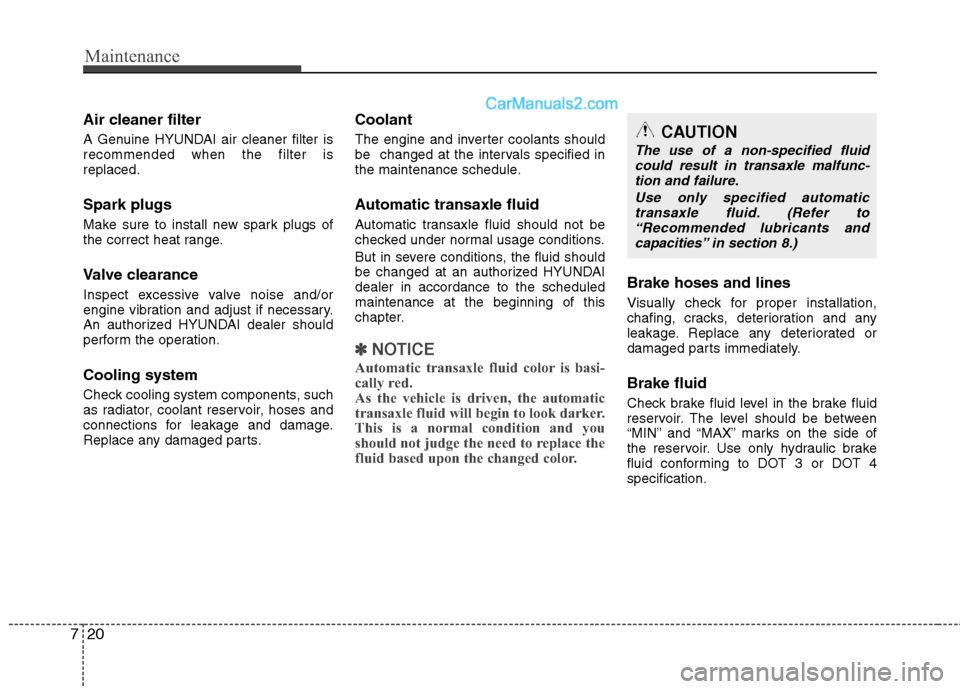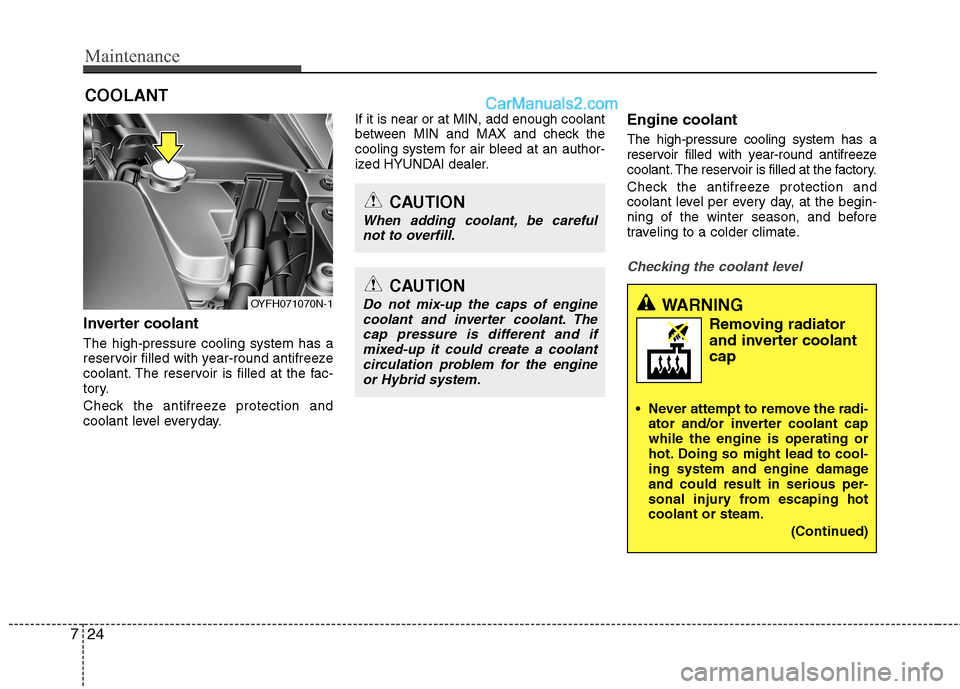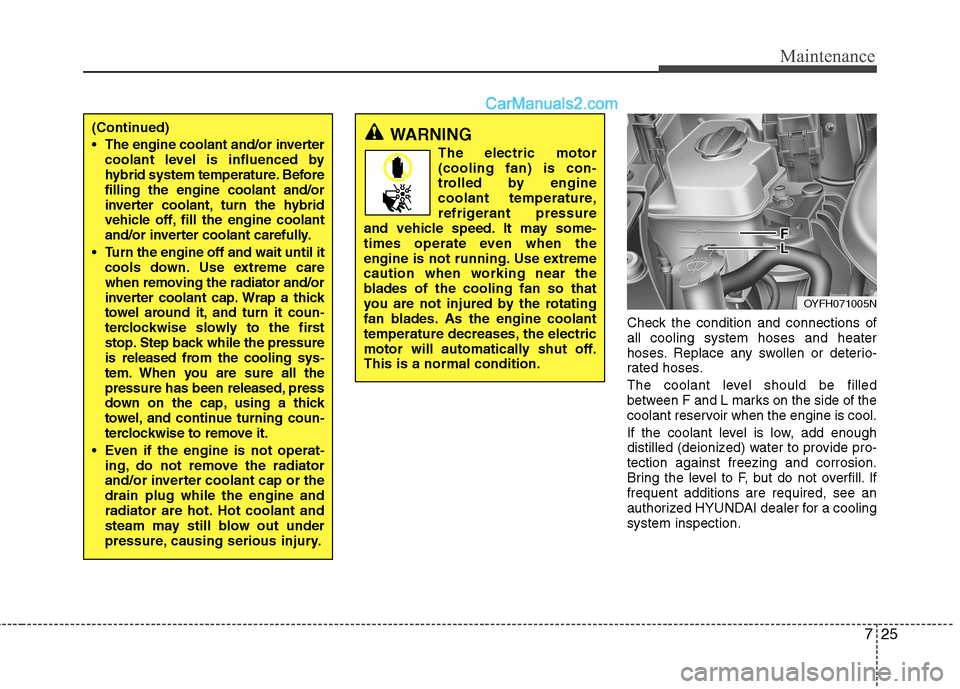2013 Hyundai Sonata Hybrid cooling
[x] Cancel search: coolingPage 334 of 425

Maintenance
20 7
Air cleaner filter
A Genuine HYUNDAI air cleaner filter is
recommended when the filter is
replaced.
Spark plugs
Make sure to install new spark plugs of
the correct heat range.
Valve clearance
Inspect excessive valve noise and/or
engine vibration and adjust if necessary.
An authorized HYUNDAI dealer should
perform the operation.
Cooling system
Check cooling system components, such
as radiator, coolant reservoir, hoses and
connections for leakage and damage.
Replace any damaged parts.
Coolant
The engine and inverter coolants should
be changed at the intervals specified in
the maintenance schedule.
Automatic transaxle fluid
Automatic transaxle fluid should not be
checked under normal usage conditions.
But in severe conditions, the fluid should
be changed at an authorized HYUNDAI
dealer in accordance to the scheduled
maintenance at the beginning of this
chapter.
✽ ✽
NOTICE
Automatic transaxle fluid color is basi-
cally red.
As the vehicle is driven, the automatic
transaxle fluid will begin to look darker.
This is a normal condition and you
should not judge the need to replace the
fluid based upon the changed color.
Brake hoses and lines
Visually check for proper installation,
chafing, cracks, deterioration and any
leakage. Replace any deteriorated or
damaged parts immediately.
Brake fluid
Check brake fluid level in the brake fluid
reservoir. The level should be between
“MIN” and “MAX” marks on the side of
the reservoir. Use only hydraulic brake
fluid conforming to DOT 3 or DOT 4
specification.
CAUTION
The use of a non-specified fluid
could result in transaxle malfunc-
tion and failure.
Use only specified automatic
transaxle fluid. (Refer to
“Recommended lubricants and
capacities” in section 8.)
Page 338 of 425

Maintenance
24 7
COOLANT
Inverter coolant
The high-pressure cooling system has a
reservoir filled with year-round antifreeze
coolant. The reservoir is filled at the fac-
tory.
Check the antifreeze protection and
coolant level everyday.If it is near or at MIN, add enough coolant
between MIN and MAX and check the
cooling system for air bleed at an author-
ized HYUNDAI dealer.
Engine coolant
The high-pressure cooling system has a
reservoir filled with year-round antifreeze
coolant. The reservoir is filled at the factory.
Check the antifreeze protection and
coolant level per every day, at the begin-
ning of the winter season, and before
traveling to a colder climate.
Checking the coolant level
CAUTION
Do not mix-up the caps of engine
coolant and inverter coolant. The
cap pressure is different and if
mixed-up it could create a coolant
circulation problem for the engine
or Hybrid system.
CAUTION
When adding coolant, be careful
not to overfill.
WARNING
Removing radiator
and inverter coolant
cap
Never attempt to remove the radi-
ator and/or inverter coolant cap
while the engine is operating or
hot. Doing so might lead to cool-
ing system and engine damage
and could result in serious per-
sonal injury from escaping hot
coolant or steam.
(Continued)
OYFH071070N-1
Page 339 of 425

725
Maintenance
Check the condition and connections of
all cooling system hoses and heater
hoses. Replace any swollen or deterio-
rated hoses.
The coolant level should be filled
between F and L marks on the side of the
coolant reservoir when the engine is cool.
If the coolant level is low, add enough
distilled (deionized) water to provide pro-
tection against freezing and corrosion.
Bring the level to F, but do not overfill. If
frequent additions are required, see an
authorized HYUNDAI dealer for a cooling
system inspection.
OYFH071005N
(Continued)
The engine coolant and/or inverter
coolant level is influenced by
hybrid system temperature. Before
filling the engine coolant and/or
inverter coolant, turn the hybrid
vehicle off, fill the engine coolant
and/or inverter coolant carefully.
Turn the engine off and wait until it
cools down. Use extreme care
when removing the radiator and/or
inverter coolant cap. Wrap a thick
towel around it, and turn it coun-
terclockwise slowly to the first
stop. Step back while the pressure
is released from the cooling sys-
tem. When you are sure all the
pressure has been released, press
down on the cap, using a thick
towel, and continue turning coun-
terclockwise to remove it.
Even if the engine is not operat-
ing, do not remove the radiator
and/or inverter coolant cap or the
drain plug while the engine and
radiator are hot. Hot coolant and
steam may still blow out under
pressure, causing serious injury.WARNING
The electric motor
(cooling fan) is con-
trolled by engine
coolant temperature,
refrigerant pressure
and vehicle speed. It may some-
times operate even when the
engine is not running. Use extreme
caution when working near the
blades of the cooling fan so that
you are not injured by the rotating
fan blades. As the engine coolant
temperature decreases, the electric
motor will automatically shut off.
This is a normal condition.
Page 367 of 425

753
Maintenance
Multi fuse
If the multi fuse is blown, it must be
removed as follows:
1. Turn off the engine.
2. Disconnect the negative battery cable.
3. Remove the fuse panel on the right
side in the engine compartment.
4. Remove the nuts shown in the picture
above.
5. Replace the fuse with a new one of the
same rating.
6. Reinstall in the reverse order of
removal.
✽ ✽
NOTICE
If the multi fuse is blown, consult an
authorized HYUNDAI dealer.
Oil pump cooling fuse/
Cooling fan fuse
If the oil pump cooling fuse or cooling fan
fuse is blown, it must be removed as fol-
lows:
1. Turn off the engine.
2. Disconnect the negative battery cable.
3. Remove the fuse panel on the right
side in the engine compartment.
4. Replace the fuse with a new one of the
same rating.
5. Reinstall in the reverse order of
removal.
Sub-relay fuse
If the sub-relay fuse is blown, it must be
removed as follows:
1. Turn off the engine.
2. Disconnect the negative battery cable.
3. Replace the fuse with a new one of the
same rating.
4. Reinstall in the reverse order of
removal.
OYFH071088NOYFH071089NOYFH071072N
Page 419 of 425

I3
Index
Capacity/Weight ······························································8-2
Care
Exterior care ······························································7-69
Interior care ·······························································7-73
Tire care·····································································7-37
Cargo weight ··································································5-43
Center console storage ·················································4-107
Central door lock switch················································4-12
Certification label ··························································5-41
Certification label ····························································8-7
Chains
Tire chains ·································································5-35
Changing tires (with spare tire) ·····································6-15
Checking tire inflation pressure·····································7-38
Child restraint system ····················································3-27
Lower anchor system ················································3-33
Seat belt ·····································································3-29
Tether anchor system·················································3-31
Child-protector rear door lock ·······································4-14
Climate control air filter ···························4-92, 4-103, 7-30
Clock (Digital) ·····························································4-110
Clothes hanger······························································4-111
Combined instrument, see instrument cluster ···············4-40
Compact spare tire (with spare tire) ······························6-15
Compact spare tire replacement ····································7-42
Components of the tire mobility kit ······························6-24
Consumer information ·····················································8-9
Coolant ···········································································7-24Cooling fluid, see engine coolant ··································7-24
Crankcase emission control system ·······························7-75
Cruise control system ····················································5-24
Cup holder ···································································4-108
Curtain air bag ·······························································3-53
Dashboard illumination,
see instrument panel illumination·······························4-41
Dashboard, see instrument cluster ·································4-40
Defogging (Windshield) ··············································4-104
Defogging logic (Windshield) ·····································4-106
Defroster (Rear window) ···············································4-81
Defrosting (Windshield) ··············································4-104
Digital clock·································································4-110
Dimensions ······································································8-3
Display illumination, see instrument panel illumination··4-41
Displays, see instrument cluster ····································4-40
Door locks ······································································4-11
Central door lock switch ···········································4-12
Child-protector rear door lock ··································4-14
Drinks holders, see cup holders···································4-108
Driver's 3-point system with emergency
locking retractor··························································3-17
Driver's air bag·······························································3-48
Driving at night······························································5-31
Driving in flooded areas ················································5-32
Driving in the rain ·························································5-32
Driving off-road ·····························································5-32
D